 It’s budget season at City Council, and there has been a lot of talk recently about whether Long Beach Animal Care Services should have its budget increased. We at Stayin’ Alive have nothing against a shelter getting more money to do its job, generally speaking – provided that they’re doing their job right. The many problems we see day in and day out at LBACS, sadly, have NOTHING to do with budget. We have been advocating for many years for free and easy changes that LBACS could make that would improve their adoptions. Here are some changes that would cost little to no money. In cases where a change would incur costs, there are things that can be done to offset them. **Include after-work hours for adoptions. Currently, you can’t adopt an LBACS animal after 5 pm on weekdays. This makes it extremely difficult for people who work to get to the shelter and adopt. Changing hours to 11:30 am – 7:30 pm (or a similar schedule) costs ZERO money and would save lives. **Expanding offsite adoptions, having adoptions in multiple locations throughout the week so that the public has greater access to the animals, which results in more adoptions and more lifesaving. **Enlisting the help of local businesses in lifesaving. Ask a large local business if they’ll partner with the shelter, either to sponsor a big adoption event. Better yet, ask a large local company (of which LB has many) if they’ll partner with the shelter on an adoption AT the company’s site. These options can be sponsored by the company as part of their mission to give back to the community. If the shelter has a strong volunteer program (as it should), these lifesaving promotions would cost almost ZERO money. **Asking local businesses to sponsor adoptions, making them low to no-fee for a weekend or particular adoption event. ZERO cost to the City; tons of goodwill and great advertising for the company. **Applying for grants (e.g., from PetCo) for things the shelter needs to care for animals, like dog yards so dogs are happy, socialized and ready to go to homes. WHATEVER need the shelter has – not just dog yards – can be financed in this way. Again, ZERO money. **Having a strong volunteer program to do daily off-site adoption programs. If one staff member’s position is dedicated to being a volunteer coordinator, the time spent on training and coordinating volunteers will more than pay for itself in valuable volunteer hours provided by animal lovers in the community. Again, ZERO cost with a net increase in labor in the tens of thousands of dollars. **Having a strong donation program. In 2015, Sacramento Animal Care Services brought in $500,000 in donations. They used this for a variety of lifesaving programs, including additional staff for offsite adoptions, diagnostic tools for blood work, and more spay/neuter surgeries. How do we know that all of these things can be done? Because Sacramento Animal Care Services has done almost every single one of these things AND did over 5400 adoptions in 2016. LBACS did an incredibly low 579 adoptions and killed nearly 1700 animals. Giving more money to LBACS without having lifesaving changes in place will just allow a resistant, unreformed, poorly-managed shelter to squander more of LB taxpayers’ newly-increased taxes to continue to engage in sheltering malpractice. Our shelter animals deserve better. Go to City Council and tell them what we need is NOT to throw more money at our shelter, but to introduce reforms, many of which are low to no-cost, that are MUCH needed at the LBACS shelter. Inform – Educate – Advocate!
0 Comments
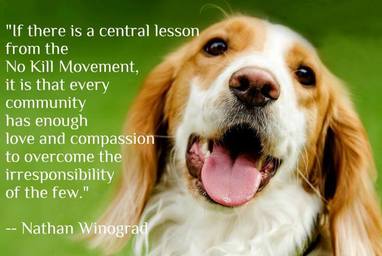 How do you know when someone rejects the No Kill approach to animal sheltering? They talk about the following: ***Punishing the "irresponsible public" instead of looking for ways of making shelters into true safe havens (because the irresponsible public will ALWAYS be with us - we need safe havens NOW)*** ***Strict enforcement of animal laws without talking about engaging the public in lifesaving, compassion and saving lives*** ***Restrictive adoption criteria instead of reasonable, education- and conversation-based adoption processes*** ***Saying No Kill shelters cause suffering by "never euthanizing" (which is not true) instead of talking about the crucial distinction that No Kill makes between euthanizing and killing. Euthanasia is a merciful release from irremediable suffering and must be done to stop suffering when that suffering cannot be relieved. Taking an animal's life when he is healthy should be called what it is -- Killing. ***Saying Spay/Neuter is the "ONLY" way instead of recognizing the many different programs / angles / process that progressive shelters can and are currently engaging in to save lives. Neuter and Spay is ONE way and one way ONLY. We need to hit the problem from ALL angles. ***Saying No Kill shelters hoard animals, rather then understanding that No Kill shelters actually create plans and pathways to get animals out of the shelter as soon as possible.*** Sometimes people make these arguments because it's what they've been told for many years. But when they hear about how No Kill **really** works, they understand and change their messaging. Other people resist the No Kill approach. These are the people who are invested in the broken shelter system, have made it work for them, and want to keep it that way. It's important to know the arguments that people make against No Kill so you can spot who is for the animals and who is for keeping things exactly the same as they've always been. What is No Kill? No Kill is LOVE. 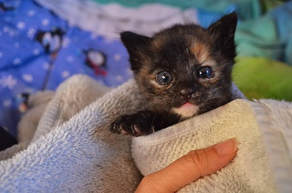 Today is NBC's "Clear the Shelters" day in Southern California, and apparently, both LBACS and SpcaLA are participating. But while other shelters in the Southland are going to do large numbers of adoptions into wonderful homes and save many lives, we anticipate that the number of animals that will be adopted at LBACS will be fairly low. This is because SpcaLA, courtesy of Mayor Garcia and City Manager Pat West, has been allowed to take up all of the real estate on these events. The animals at SpcaLA will be the first to be considered by the public, with LBACS animals getting second priority. How do we know this? The media coverage on this is dominated by SpcaLA. When we opened the video below, we thought we'd see Ted Stevens from Long Beach Animal Care Services speaking because the video title says "Things to Know Before Adopting at the Long Beach Animal Shelter." Instead, it's the SpcaLA manager talking about "When you adopt from SpcaLA" and "Adoptions at SpcaLA." Notice it's not "When you adopt from the Long Beach animal shelter." There's a difference. One highlights Long Beach animals. The other highlights SpcaLA as the adopting agent. Another point to mention: SpcaLA makes it hard to adopt from them. Other progressive shelters and national organizations have moved to a program of "Open Adoptions," by which potential adopters are screened via application and interview and are educated about how to be a responsible pet guardian. SpcaLA really wants to put you through your paces. To adopt from SpcaLA, you have to bring, not only your ID, your compassion and a willingness to give a good home to an animal, but also: - A copy of your lease, - The phone number for your landlord, apparently for a phone check on whether your lease is accurate - Every member of your household and - Your dog, if you have a dog These excessive requirements are now recognized by national welfare organizations such as HSUS and ASPCA as unnecessary and a hindrance to adopting. So while we're happy that some animals will be adopted into loving homes today - it won't be as many as it should be, and the animals who are most at risk, at LBACS, will still remain second class citizens. Come Monday, animals will be killed who would have been adopted out today in a more progressive shelter system. Watch the video here: http://www.nbclosangeles.com/…/Clear-the-Shelters-How-to-Pr… #Cleartheshelters  City Council’s discussion around animals was brief at last Tuesday's meeting, in spite of the fact that a number of people spoke during public comment on the budget presentation by Parks, Recreation and Marine, the city department which houses Long Beach Animal Care Services. Parks, Recreation and Marine head Marie Knight kept her comments about LBACS brief, recycling LBACS’ inaccurate mid-year numbers and talking about LBACS’ progress in reducing “the unwanted pet population.” The issue of the inaccurate numbers aside (Stayin' Alive has written a report about LBACS' inaccurate reporting practices, which can be found here: https://goo.gl/sDgNZP), we’d like to point out that words matter. The use of the term “unwanted pets,” by the head of Parks and Rec to describe our shelter animals perfectly encapsulates the deficit view that City administration has of our shelter animals, and it is this negative and pervasive view that keeps our shelter animals suffering in a broken shelter system. We can only hope that through education about how other cities are saving lives through No Kill programs, this view will change. Knight ominously warned that recent increases in the save rate at LBACS “may plateau” if the City doesn’t invest further in space and “intervention resources.” It’s unclear what was meant by intervention resources, but one thing we do know: The City only needs more space because it warehouses animals for far too long, and does so because there is no strong adoption and foster program. This often results in inhumane treatment of animals and points to much bigger issues than simply “space.” Knight also talked about two new positions requested for LBACS in the next fiscal year. New positions are all well and good, but without a strong framework of programs in place, and a change in culture, these types of cosmetic changes, even if they come in the form of new positions or more money, will not make a difference. The sadly remarkable thing about the evening was the apparent lack of interest most of the council members showed in the comments of those who spoke on behalf of the animals. After public comment, city council members have an opportunity to ask questions about the budget presentations by city staff. After listening to almost 40 minutes of public comment, the vast majority of which was about shelter animals, here is how the City Council members responded: Vice Mayor Rex Richardson, District 9: Deferred questions to a later date. No questions about LBACS or shelter animals in council. Lena Gonzalez, District 1: No questions about LBACS or shelter animals Susie Price, District 3: No questions about LBACS or shelter animals Daryl Supernaw, District 4: No questions about LBACS or shelter animals Dee Andrews, District 6: No questions about LBACS or shelter animals Roberto Uranga, District 7: No questions about LBACS or shelter animals Al Austin, District 8: No questions about LBACS or shelter animals Mayor Garcia was notably absent. The only two councilmembers who addressed in any way the issue of our shelter animals were Stacy Mungo, District 5 and Jeannine Pearce, District 2. Stacy Mungo brought up two points, which to our knowledge have never been publicly acknowledged by a city council member, though many of them have known about it for years. The first was the question of how to address the many problems caused by the City’s troubled 19-year partnership with SpcaLA, which has been absolutely disastrous for Long Beach’s shelter animals. This was the first time to our knowledge that the stranglehold the City administration allows SpcaLA to have on LBACS has ever been acknowledged. We hope, for the sake of the animals, it won’t be the last. Second, Stacy Mungo asked her colleagues if they would be open to an ordinance that would have an impact on the problems at LBACS. She was not specific about what such an ordinance would look like, but Stayin’ Alive has long advocated for an ordinance similar to that passed by the City of Austin, which resulted in that city’s being the nation’s largest municipal shelter to reach and maintain No Kill status. We will be monitoring any ordinance development that may occur going forward and offering our input. You can read Stayin' Alive's model ordinance here: https://goo.gl/x9qozK). Jeannine Pearce, who Stayin’ Alive supported in the last election, also spoke about issues at LBACS, asking Knight about the possibility of a presentation by LBACS about exactly how it runs its programs and operations. Significantly, Jeannine Pearce noted that it may be time to ask what kind of shelter we want to be, which speaks to an interest in a deeper look at LBACS. This is a departure from how city council members have behaved in the past, preferring instead to perpetuate the myth that LBACS is doing great. More importantly, she also admitted to having spoken to Sacramento Animal Care Services and the Austin Animal Center (Stayin’ Alive specifically asked Jeannine Pearce through a series of meetings to contact Sacramento and Austin to find out about the programs they put in place and how Austin was able to reach No Kill – we’re happy to hear that she followed through). In the end, the facts remain: it’s not about money, and it’s not about space. It is most definitely not about asking SpcaLA to take more animals in, given that SpcaLA opposes No Kill and is not accountable to the public. It’s about changing the culture at LBACS and passing an ordinance that codifies LBACS’ priorities and requires it to put in place lifesaving programs. While we see faint glimmers of that from time to time, this time provided by Jeannine Pearce and Stacy Mungo, it is clear that much more advocacy remains to be done by Long Beach animal lovers to ensure that our shelter is a safe place, where they are truly sheltered from the storm of human whim and circumstance. We encourage all community members in Long Beach to share your voice at the next City Council meeting. Our shelter animals need ALL of us to be their voice.  When we first began advocating for No Kill in Long Beach five years ago, a very small group of people started grumbling that No Kill actually meant "never euthanize" and led to animal cruelty and warehousing of animals at shelters. Of course, nothing could be further from the truth, and we soon cleared that up, speaking at City Council to clear up ANY misunderstandings whatsoever. We'll take a moment to do that again here on this page today. To first address the mistaken idea that animals are not euthanized when they are suffering under No Kill: This is completely, totally and unequivocally INCORRECT. No Kill absolutely believes in euthanasia of animals that are suffering and are past help. In those cases, euthanasia is humane and necessary to relieve irremediable suffering. However, if an animal is deemed treatable by a veterinarian, euthanasia is not appropriate: Treatment is. No Kill makes a very clear distinction, then, between killing, which is the taking of the life of animals that are healthy or treatable, and euthanasia, which is the taking of the life of an animal when it is irremediably past help. That's the No Kill stance on euthanasia, but what makes No Kill an eminently effective approach to sheltering is No Kill's emphasis on having a secure, stable and reliable system in place, in the form of programs, that 1) supports the public to keep animals out of the shelter if possible, and 2) gets animals out of the shelter as quickly as safely possible once they're in. People who bring up completely erroneous definitions of No Kill are generally attempting to discredit it as a movement. They are disgruntled people in the sheltering profession who invested their time and effort into a broken system and basically bought into the idea that you can only save some of the animals some of the time, and have to kill the rest. Some of them have found ways to make significant amounts of money through this broken system and see No Kill as a threat to their revenue stream. This is enough for them to fight innovations in animal sheltering tooth and nail, in spite of the fact that in doing so, they are advocating for the unnecessary killing of animals. The solutions to animal killing in our shelters that originated in the No Kill movement are being implemented successfully in shelters across the nation. If it's being done by other shelters, it can be done, and opposing the programs that No Kill advocates for is both irrational and harmful for animals. No Kill is a movement whose time is here. The animals have waited long enough for humane shelters that offer lifesaving instead of death. It is absolutely certain that the majority of shelters in this country will one day be No Kill shelters, and we'll look back on this dark time in our history and wonder how people could have ever argued against it. Be on the right side of history - advocate for our shelter animals. Know what No Kill REALLY is, and spread the word. INFORM - ADVOCATE - EDUCATE - SHARE 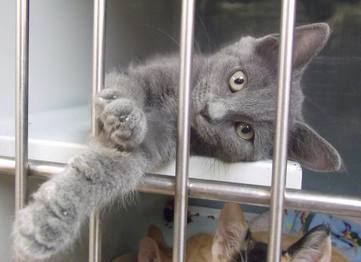 Although we talk about dogs a lot here, we at Stayin' Alive are equally concerned about the high kill rate of cats at the Long Beach animal shelter. Cats are wonderful companions: Cats are affectionate, they're playful, they show gratitude, they comfort us, they provide us with moments of joy and contentment, and sometimes they are elegantly reserved. As the writer Jean Cocteau famously said, cats are the home's "visible soul." ***Kitty Hall Comments Bad for Cats*** That's why were dismayed to see how cats were characterized by Long Beach Animal Care Services Manager Ted Stevens at the Kitty Hall on Friday. At a cat-centered event, Mr. Stevens should be explaining the positive attributes of cats and educating people about how to care responsibly for them. Instead, captured on video at Kitty Hall by the Press-Telegram, Mr. Stevens said this: "Cats are great pets, especially for people that have to work all day. They're really good. They take care of themselves, you know, they can use litter boxes. They make great pets for working people. They're just great all around." This might sound like no big deal, but this is the Manager of the Long Beach shelter – a facility that kills animals, most of them healthy or treatable. ***LB Shelter Animals Need a Manager who Doesn’t View Animals as a Burden*** Mr. Stevens’ comments are an example of exactly what our shelter animals DON’T need. Our shelter manager needs to be someone who actually likes animals, who believes in the joy of the human-animal bond, and who knows how to advocate for animals and whole-heartedly promote them so that they can find good homes. These comments read to us like someone who views animals as a burden, saying essentially that cats are great, not because they are affectionate or good companions, but because they don't require a lot of work or attention. ***How Negative Views by Management Hurt Our Shelter Animals*** This is a negative view of animals, and of cats in particular, and it hurts our shelter animals in three ways: 1) It's a terrible way to promote adoptions. Who wants to adopt an animal whose only positive trait is that it takes care of itself? Cats have many positive attributes. If Mr. Stevens doesn't know what they are and can't articulate them to the public, he should be in another line of business. 2) It endorses indifference to cats at best and neglect of cats at worst. Cats enjoy and need interaction. While it's fine to have one cat and go to work during the day, many cat guardians have more than one cat to provide for the social needs of their cats. Or they make sure their cat has appropriate enrichment during the day. These comments are not aimed in that direction. We find that troubling. 3) If this is the way the manager of a facility that kills animals talks about animals, then there is no doubt that this attitude colors the culture of the shelter and makes it more difficult for lower level staff, who want to help animals, do their work well. The manager sets the culture of the workplace. Portraying animals as desirable because they are not a lot of work is not an attitude that helps our shelter animals get adopted. Mr. Stevens said at the LBACS Open House this year that his goal in 2017 is to kill under a thousand animals. We remind you that this is a goal for killing, not a goal for lifesaving. We maintain that this is an inappropriate disposition for a shelter manager to have. Please continue to advocate for our shelter animals. We need REAL change at the Long Beach animal shelter. If not: Thousands of animals will continue to be killed every year. For no good reason. And that is NOT okay. 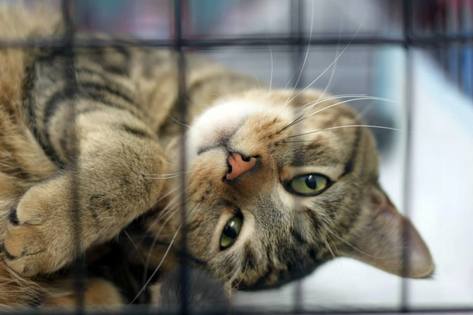 Today there will be a cat adoption event at City Hall -- Mayor Garcia bills it as Kitty Hall. Local media are reporting that a TV film crew from a PBS television show will be filming there today, no doubt at Garcia's request in an attempt to deflect the criticism levied against him by animal advocates in Long Beach for the Long Beach shelter's dismally low adoption numbers. While we could not be happier for all the cats who are saved at Kitty Hall, it is clear Mayor Garcia is doing it for himself, and the publicity PBS will give him, and not for the cats. Because if Mayor Garcia truly cared about cats, he would do more. Indeed, the animals and good people of Long Beach deserve more than what Mayor Garcia is willing to give them. LBACS has done 285 adoptions this year (compared to Sacramento's 2,274) and the Mayor has stonewalled more lifesaving at every turn. The only thing Mayor Garcia has ever done is two Kitty Hall events in two years that have saved about 53 cats total, while LBACS has killed more than 6,000 animals since Mayor Garcia was elected. And now PBS is a pawn in Garcia's reelection campaign. Because this much is clear: if he gets reelected, he'll once again turn his back on the cats (dogs, and other animals) being slaughtered under his watch by the thousands - unless people speak out. Kitty Hall will happen from 11-3 at 333 W. Ocean Blvd today. Adoptions are $20. Please go and save a life. LBACS is still one of the worst possible places for an animal to be in Long Beach. We hope that having a third isolated experience with an adoption event -- when offsite adoption events should be the norm and happening at a much, much greater rate -- will help Mayor Garcia see that adoptions to the loving people of Long Beach are the best way to increase the save rate at our shelter. But hoping isn't a plan. We urge people to continue to speak out about what is happening to our shelter animals. The animals need YOU to be their voice.  As we await the results of the city audit of Long Beach Animal Care Services, we would like to share with you another point we discussed with the third-party shelter consultants hired by the Auditor's office. It's the issue we've all been focused on for the past few days, regarding Mayor Garcia's and the City's inaccurate methods for reporting progress in lifesaving. Stayin' Alive wrote a report in February of this year documenting the problems with the City's, LBACS' and the Mayor's method for calculating progress in lifesaving at our shelter. The report was submitted to the Auditor in the hopes that she will examine the unorthodox and non-transparent methods the City uses to exaggerate progress at the LBACS animals shelter. It was also featured in the Press-Telegram article that came out last week. The problem with inflating the numbers is that it is dishonest, for one thing. And that should be enough for us as a city to call out the Mayor on this practice and demand true transparency AND shelter reform. But specifically in the context of animal sheltering, it's an enormous problem because it's basically a condescending "pat on the head" to concerned community members and an attempt to dismiss their requests by sweeping LBACS' NOT insignificant problems (which include the illegal killing of the dog, Thor, who had an adopter waiting for him) under the rug. Instead, the City should be engaging with the public in an authentic and honest way that leads to positive, implementable programs and solutions that save shelter animals' lives. You can read the report here: https://goo.gl/sDgNZP 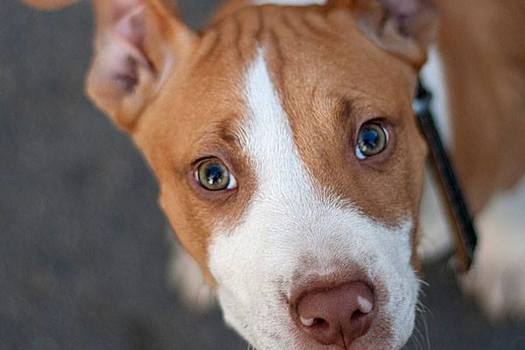 Today we're reporting on more irresponsible number-wrangling from Long Beach Animal Care Services, Mayor Garcia and the City. In a press release sent out yesterday, LBACS and the City, with Mayor Garcia’s full endorsement, are once again attempting to mislead the public about progress at the Long Beach animal shelter by significantly inflating LBACS’ live release rate. Using bogus methods for reporting live releases and partial mid-year numbers that inaccurately represent LBACS’ yearly performance, the press release trumpets a live release rate of 95% for dogs in the first six months of 2017, up from 89% in 2016, as well as overstated numbers for live releases for cats. This is a clear example of what is known in animal advocacy as “shelter math.” It's what we've come to recognize in this day and age as "fake news." Bottom line -- It’s what bad shelters do when they want to keep their killing out of the public’s view. When reputable shelters report live release rates, they do so for the entire year, not just for part of the year, as Long Beach routinely does. Why do Long Beach bureaucrats (read: Mayor Garcia, City Manager and LBACS Manager) do this? To maintain the myth that has endured for more than a decade in Long Beach: the incorrect belief that LBACS is a no kill shelter (it’s not) and is doing much better than it really is. In this way, the City hopes to deflect public criticism of the needless killing that goes on in our city shelter. Here are some facts you need to know in order to evaluate the bogus numbers recently put out by the City: *** LBACS has never in its history had an actual live release rate of 89% for dogs. In 2016, the year-end live release (save) rate was 85% - that is a full 4 percentage points lower than the number cited in the press release. The year-end rate is the only accurate method for reporting live release rates – mid-year press releases distort the true numbers and are used by the City as a smokescreen to inflate the numbers and deceive the public. With Mayor Garcia running for re-election and scurrying to curry favor with the animal-loving community to win its vote, it’s no surprise to see the renewed zeal with which LBACS is reporting the numbers this week. *** The inflated and grossly inaccurate figure of 95% for 2017 the City reports completely leaves out the high-kill months of July-November, which are the worst months of the year for dogs at LBACS. When those months are finally factored in at the end of this year, it is highly likely that LBACS’ actual save rate for dogs will be significantly lower. *** The City’s claim of a 76% save rate for cats is as misleading as it is heartbreaking: we are in the middle of kitten season, the deadliest season for kittens at LBACS. LBACS has killed over 250 kittens so far this year, and with several months of kitten season remaining, that number will only increase. It is impossible for the City or anyone else to accurately say at this point what LBACS’ save rate for cats and kittens will be by the end of this year, but we do know the numbers from last year – more than 800 kittens and 400 cats were killed in 2016. In other words, the killing season at LBACS has only just begun, and calling out live release rates at this point of the year is both irresponsible and inaccurate. *** The double-digit decreases in euthanasias that the City cites are not only inaccurate; they're also dishonest because they intentionally utilize a method for reporting decreases that is not the industry standard and is clearly utilized to deceive the public. Stayin’ Alive has written a report detailing the inaccuracies in these reports of progress, which you can read here: https://goo.gl/sDgNZP All that said, consider this: If the City can get you to remember these inflated and grossly inaccurate figures, they have a chance at making you forget about the more than 1660 animals they killed in our shelter last year, many of whom could have been saved. Note that the only numbers these press releases ever mention are numbers of impounded animals and euthanized animals – the number of adoptions, fosters or other outcomes are never mentioned. So here are the numbers the City and Mayor Garcia DON’T want you to see: ***Let’s start with 285. That’s the number of adoptions LBACS has done so far this year. In the first six months of 2017, LBACS adopted out only 285 cats, dogs, kittens and puppies. These numbers are extremely low when one considers that Sacramento adopted out nearly 10 times that number of animals in the same time frame. From January to June of this year, Sacramento has adopted out 863 cats and kittens and 1411 dogs and puppies for a total of 2274 adoptions. Sacramento continues to literally run circles around Long Beach in terms of adoptions. Mayor Garcia knows about Sacramento and got elected by promising to increase adoptions, and yet he has done almost literally nothing to increase the number of adoptions done by LBACS since he was elected. (Two Kitty Halls do not an adoption program make). ***Next is the number 3 (yes, THREE). That’s the number of animals that have gone into foster homes in the past six months at LBACS. Sacramento routinely has 200+ animals in foster homes during any given month. Foster programs are a key part of shelter lifesaving. The fact that LBACS still does not have a robust foster program is beyond outrageous, given the fact that LBACS boasts a huge animal-loving community that would no doubt be willing to foster animals for a City-run program. *** The next number is 36. That’s the heartbreakingly-low number of kittens that have been adopted out by LBACS since January. During the same period, LBACS killed over 250 kittens, and the number is rising. If LBACS had a proper foster program, the majority of those lives could be saved, but LBACS continues to resist taking responsibility for having its own foster program, preferring instead to foist the task off on overworked, under-resourced rescues who don’t have the reach and influence that a city shelter has and are left to flail under the weight of doing the job that the animal shelter in the 7th largest city in the 6th largest economy in the world should be doing. As we have noted elsewhere, if Long Beach had a strong adoption and foster program, a medical and behavioral rehabilitation program, and other progressive programs, we would be No Kill by now. If LBACS did just seven more adoptions per day, we’d be saving more than 90 percent of our shelter animals. However, because of a lack of any genuine interest in saving lives and because of a lack of action on the part of Mayor Garcia and City Council, Long Beach will slowly weave and stumble toward a save rate that could have been achieved years ago. And more animals will die. Since Mayor Garcia was elected, more than 6,000 dogs, cats, kittens and puppies have been killed at LBACS. Since City Manager Pat West was hired and then retained in his position by Garcia, more than 46,000 of our beloved companion animals have been killed at LBACS – 46,000 animals. That’s enough to fill a small city. Yet the City and our elected officials continue to deny, deflect and evade responsibility for their lack of caring and lack of action. Please share this post – our shelter animals need YOU to be their voice. One of the first things people think when they hear that LBACS is not doing as many adoptions as Sacramento is this: "LBACS doesn't have enough money."
We thought that, too. And then we did some research. And we found out it's not about the money. It's about a change in the culture at LBACS away from its current old-school animal control-oriented "we've always done it this way," "blame the public" mentality to a progressive, lifesaving, positive, think-outside-the-box mindset that is taking over the sheltering field. This progressive mindset is the approach of the Director of ACS in Sacramento. And it shows in Sacramento's numbers. Sacramento: Less money than LB, but still more adoptions. Sacramento: No "help" from a so-called "partner" shelter; still more adoptions. No more excuses. Adoptions and positive programs save lives. |
Archives
June 2022
SALB
An initiative to make Long Beach a No Kill community. Categories |
No Kill Long Beach
- Home
- ::NKLB in the News::
- 2020 Voter Information Guide
- How you can help
-
Get Informed
- Contact Us
- LBACS's Numbers
- Model No Kill Ordinance
- LB City Officials' Contact Info
- No Kill Long Beach Blog
- Justice for Thor
- LBACS Complaints
- A Shelter in Crisis
- 2018 Candidates' Responses
- LBACS Document Archive
- Why "Compassion Saves" is No Good
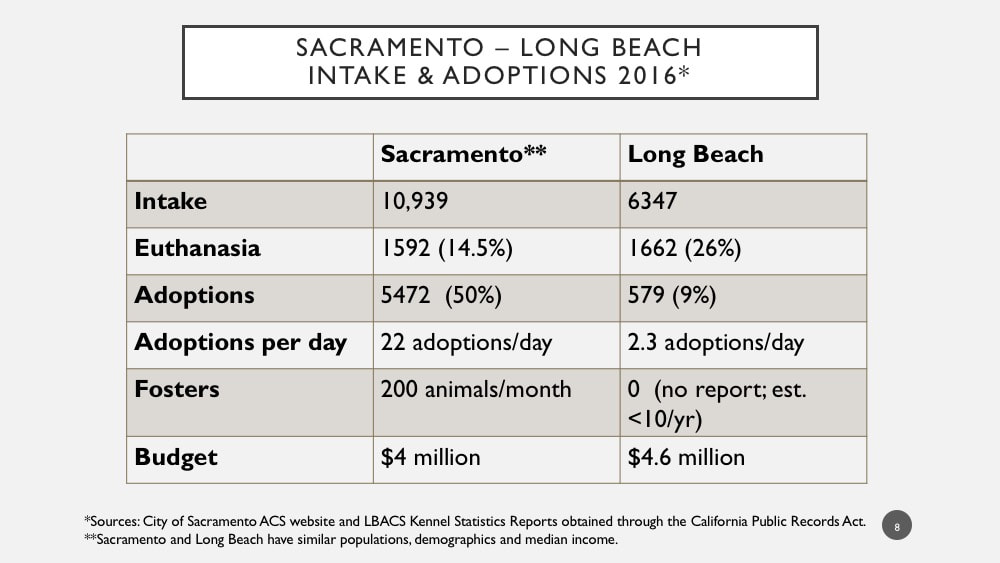
 RSS Feed
RSS Feed
